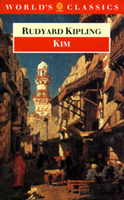
 "This
is the great world, and I am only Kim.
"This
is the great world, and I am only Kim.
This book is hold in high regards by many
people as a essential imperial novel. The setting, the characters, the
author (that is Rudyard Kipling) and the ideologies are all simply covered
with imperial references and ideas. The story is about a Irish, young,
white orphan living in the streets of Lahore in the middle of the Imperial
Taj before meeting a Tibetan Lama. The boy befriends a budhist lama and
together they wander the highways and byways of India looking for the objects
of their respective requests. They meet a lot of people in their travels
from all races and creeds of life. The most important thing in this book
is the diversity of what was Imperial Indian and the enrolment in the Indian
Secret Services and a thrilling climax in the Himalayas. Lanscapes, castes,
professions, religious are all described in detail for you. Kipling permit
us to visit this exotic and enjoyable and experience the sights, sound
and tastes that his characters live through.
It is the better history of rail travel
in Imperial India. The third travel contains life and character of indian
peoples going about their lives and businesses. For another hand, the descriptions
of the Europeans in the first class carriages shows how lonely, and cut
off they had made them from populace. More things are interesting and doing
reference ti the imperial historian in this book as when one of his characters
explains why the Grand Trank Road that straddled India had fallen into
disuse as far as the whites were concerned. They obviously were taking
the train at his point leaving the road to traders, locals and the army.
In the book we have two differen points Kim as
a vagabond travelling around India with his Lama mentor and Kim all grown
up and playing The Great Game on behalf of the British governament. Kipling´s
message is steeped in Indian culture. For Kipling ,people aren´t
greater or lesser than any one else , thay all have their roles , virtues
and vices. Kipling mades asides such as "the white man is very wise in
some mattters and very foolish in others" or when Kim reminds the Lama
that he is "neither black nor white". In short, Kipling said that those
whites who do give their heart and soul for India and try to gain
an understanding would be much better at running and ruling the country.
The nore silly part of the novel is the
sectionn of The Great Game. We, the readers, perceive as if Kim gets years
quickly and after he loses some of his initial characters but he
still maintains a touching relationship with his lama mentor and still
travels the world eager to learn . Kim realises that all the things in
the world happen for a reason.
The endins is not an exciting one
and many thins are open yet as so questioneds unanswered, jobs undone and
places yet to visit. this ending is a typical kind of buddhist one being
a very eastern piece of literature.
"Kim" is a basic novel in your own library
and you must acquire it if you haven´t it yet. It is an authentic
snapshot of the Orient world and Indian Imperialism. You can complete the
vision of this novel with some of the films based in it.
IF YOU ARE INTERESTED IN THIS NOVEL YOU CAN READ
IT ON-LINE IN THE FOLLOWING DIRECTION
http://bygosh.com/Kim/C006.htm